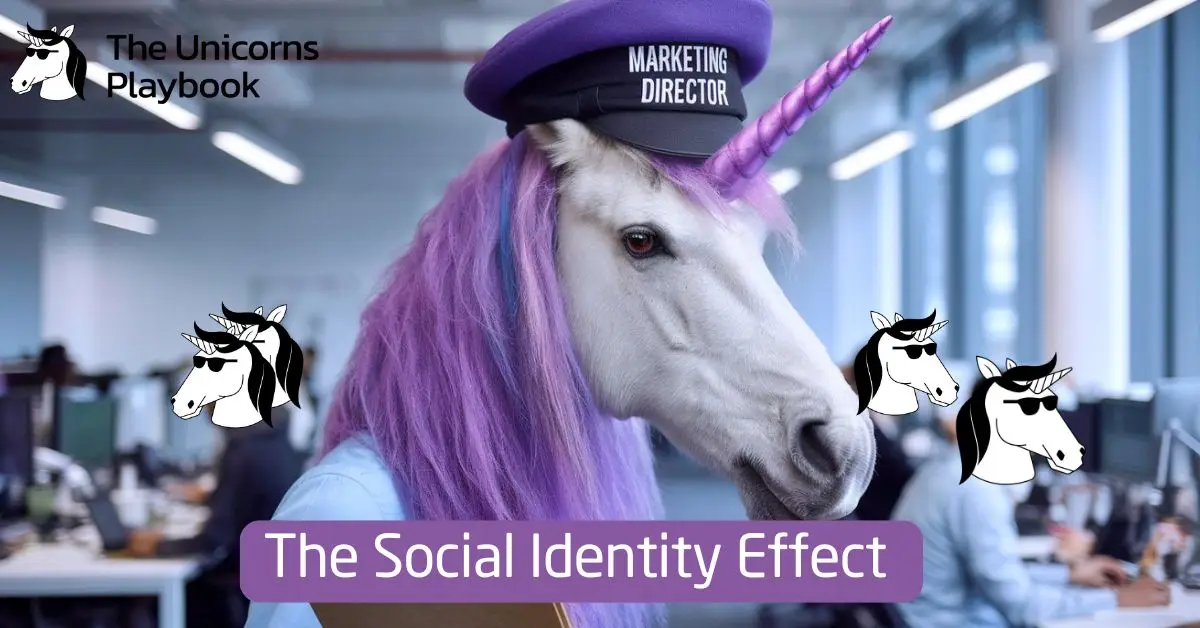
Ever noticed how Tesla drivers wave at each other on the road?
Or how do Reddit users instantly bond over shared subreddit memberships?
Welcome to Social Identity Resonance!
And here’s the fascinating part:
This psychological principle isn’t just about belonging – it’s about how shared identity shapes our behavior and decisions.
📚 The Story Behind Social Identity

In 1979, social psychologists Henri Tajfel and John Turner introduced Social Identity Theory in their seminal work “An integrative theory of intergroup conflict”.
Their research revealed that humans naturally categorize themselves into social groups and derive significant emotional value from these memberships.
The theory emerged from Tajfel’s earlier groundbreaking experiments on intergroup discrimination (Tajfel et al., 1971), which demonstrated that even minimal group memberships could trigger:
- In-group favoritism
- Group-based identity formation
- Social categorization processes
This wasn’t just about belonging – it was about how group membership fundamentally shapes our behavior, choices, and loyalty.
🧪 The Science of Belonging

Social Identity Theory has been extensively studied in consumer behavior research, revealing fascinating insights about how group identity influences our decisions (Hogg & Terry, 2000).
Group Identity Effects: Research published in the Journal of Consumer Research shows that when people identify strongly with a brand community, they:
- Become more resistant to negative information about the brand (Ahluwalia et al., 2000)
- Are more likely to advocate for the brand (McAlexander et al., 2002)
- Show higher brand loyalty even when offered cheaper alternatives (Marzocchi et al., 2013)
Community Validation: Studies in social psychology have demonstrated that group membership satisfies fundamental human needs (Baumeister & Leary, 1995):
- The need for belonging
- The desire for social identity
- The search for meaning through group affiliation
As consumer psychologist Dr. Susan Fournier noted in her seminal work “Consumers and Their Brands: Developing Relationship Theory in Consumer Research”, “Brands can and do serve as viable relationship partners.”
💼 3 Ways to Make the Identity Effect Your Secret Weapon

1) Build an “us vs. them” narrative
Don’t shy away from positioning your community as unique and special.
With social identity theory, it’s not just about building a community—it’s about creating a clear sense of what makes your group different and better.
This helps members feel they’ve made the right choice by joining your tribe.
Look at how Webflow positioned their users as “visual developers” versus traditional coders.
Their community proudly embraces building without code, creating a distinct identity that separates them from traditional developers.
Or how Canva transformed their users into “design creators” rather than just “people who need graphics,” making them feel empowered and distinct from those needing professional designers.
Careful, though: Keep these comparisons light and fun. You want to celebrate your community’s uniqueness, not create enemies.

2) Foster active community participation
Building a community is just the first step. The real magic happens when you nurture it.
Community isn’t just about having users—it’s about creating a space where members actively participate, share, and support each other.
Look at how Miro turned their template gallery into a thriving marketplace where users share and celebrate each other’s work.
Consider how Airtable’s “Universe” became more than just a template repository—it’s a place where members showcase their innovative solutions and teach others.
Their power users even get recognized as “Airtable Experts” creating a hierarchy that members aspire to climb.
Calendly’s user stories aren’t just case studies—they’re celebrations of members who’ve mastered the art of professional scheduling, making everyday scheduling feel like a skill to be proud of.

3) Connect to a larger purpose
Sometimes, the strongest communities form around shared beliefs, not just shared products.
Your brand can tap into existing movements and values that resonate with your target audience.
This creates deeper connections that go beyond features and benefits.
Look at how Notion positioned itself beyond just being a productivity tool—it became a symbol of modern, transparent workplace culture.
Their users don’t just organize notes; they’re revolutionizing how teams work together.
ConvertKit doesn’t just provide email marketing—they champion the “creator economy” movement, making their users feel part of the revolution in independent online business.
Even Buffer turned social media management into a statement about transparent business practices, sharing their salaries and metrics publicly, making their users feel part of a movement toward business authenticity.

🎯 Social Identity Resonance in Action

Notion: Building a Knowledge-Sharing Community 📝
The productivity tool space is crowded with feature-rich applications.
Yet Notion has distinguished itself not through features, but through community.
What makes their approach notable:
- They created “Notion Ambassadors” program for community leaders
- Built a template gallery for member knowledge sharing
- Enabled natural community formation through user groups
- Fostered education through community-led workshops
The result isn’t just a user base – it’s a community of practice where members actively help each other succeed.

Roam Research: Building the “Roamans”
This note-taking app turned their users into a passionate cult-like following by:
- Calling their users “Roamans,” creating an immediate sense of ancient wisdom and scholarship
- Developing unique terminology like “networked thought” and “bi-directional linking” making members feel like pioneering thinkers
- Creating “#RoamCult” as their community hashtag, which users proudly adopted
- Fostering a sense that their users are the intellectual elite who “get it” versus those using “ordinary” note-taking apps
The result?
Users who call themselves “Roamans” spend an average of 5 hours more per week in the app compared to regular users, and they become passionate evangelists for the product.

Descript: Creating the “Audio Alchemists”
This AI-powered audio/video editor has built a unique community by:
- Positioning their users as pioneers of modern content creation, not just editors
- Creating “Descript Stories” where users share how they’re reimagining audio production
- Building a community around challenging traditional editing workflows
- Making complex audio editing feel accessible to non-technical creators
Their community became so tight-knit that when they launched major features, existing users acted as voluntary mentors to newcomers, creating a self-sustaining support system.
What makes these examples special is how they turned seemingly ordinary software tools into identity-forming communities.
They prove you don’t need millions of users or a huge brand to create strong social identity resonance—you just need to give people a compelling identity to connect with.

💡 The Social Identity Takeaway
Here’s the truth:
Building community isn’t about forcing connection – it’s about creating spaces where natural bonds can form.
Social Identity Theory teaches us that people naturally seek belonging.
Your role is to:
- Enable authentic connections
- Foster natural community development
- Support genuine member interactions
- Create space for shared experiences
Remember: In a world of transactions, genuine community creates transformation.
After all, it’s not about manufacturing belonging – it’s about enabling your community’s natural desire to connect around shared purpose and identity.


Leave a Reply